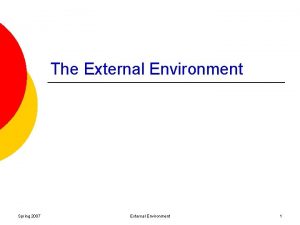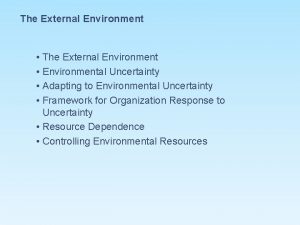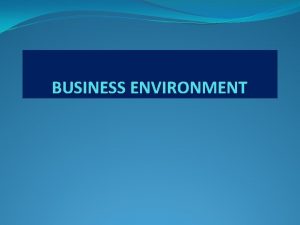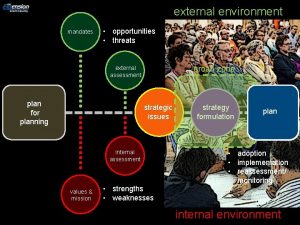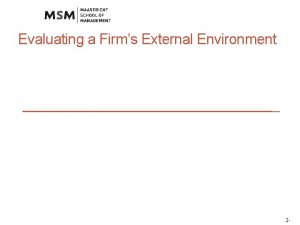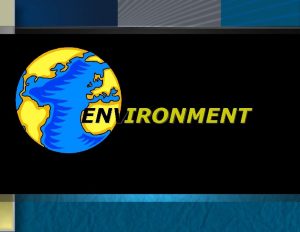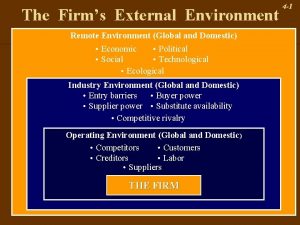Lecture 2 External Environment The external environment of


















- Slides: 18

Lecture 2 External Environment

The external environment of companies General environment Industrial environment company

The Components of a Company’s Macro-Environment MACROENVIRONMENT The Economy at Large y po og l no lit Te ch Suppliers Rival Firms So cie an tal V dc a ult lues ure Substitutes ic COMPANY Buyers New Entrants IMMEDIATE INDUSTRY AND COMPETITIVE ENVIRONMENT al r u t Na urce o res al

General environment • PEST – Political environment: • law, peace, – Economic environment: • development level, economic system, price, labor and etc. • GDP, interest rate, exchange rate, CPI? – Social and cultural environment: • population, value and so on – Technological environment

• Technical development – Industrial technology – Internet

• Social and culture – aging population – At the end of 1990’s,old ages in china is over 10%,at the middle of 2000’s, old ages may be over 30%. – 2004,average old ages rate is 10. 97%, Shanghai(18. 48%), Tianjin(13. 75)、 Jiangsu(13. 75%)、Beijing(13. 66%)、 Zhejiang(13. 18%).

• Natural resources – Analysis natural resources of Shanghai

EFE-external factors evaluation (外部因素评价矩阵) 1、key factors 2、weight for each factors (0 -1)。 3、score for each factors 4、weight * score for each factors 5、added all the weighted score。

Industrial environment Substitute Products (of firms in other industries) Suppliers of Key Inputs Rivalry Potential New Entrants Buyers

Rivalry: Current competition • Number of competitors and their relative sizes • Cost structure • The industrial development (growth rate): • Differences of products and services • Barrier of exiting

• E. g. – Automobile industry – Beer – supermarket – Express: UPS/FEDEX/DHL /EMS/TNT

• Strategic groups – The companies that have same strategy or similar strategy in the industry – Example:

Bargaining power of suppliers • Concentration of the upper stage of production chain • The difference of products of different suppliers • The menace of substitute products • The forward integration power of supplier • The importance of the company to its supplier

Bargaining power of buyers • The purchase volume of buyers • Standard products or not • The cost position of the product for customer • The profit level of buyers • The transferred cost of buyers • The backward integration power of buyers

Substitutes • The new industry • The effect to profits Examples Eyeglasses vs. Contact Lens 4 Sugar vs. Artificial Sweeteners 4 Newspapers vs. TV vs. Internet 4 E-mail vs. Overnight Delivery vs “Snail mail” ( Post Office) 4

The entering and exiting barriers Entering barriers high Exiting barrier high low high risk, high profit Low risk, high profit low high risk, low profit low risk, low profit

Beyond the 5 -forces • Too much emphasis on adversarial “value capture”, not enough on “value creation” • Too much emphasis on competition not on cooperation • Too much emphasis on Industry, not on company’s resources and ability (Industry accounts for about 20% of total variance in ROA) • Evolution of industry structure

• Discussion • Why does automobile industry become more competitive recently?
 01:640:244 lecture notes - lecture 15: plat, idah, farad
01:640:244 lecture notes - lecture 15: plat, idah, farad Khi nào hổ con có thể sống độc lập
Khi nào hổ con có thể sống độc lập Diễn thế sinh thái là
Diễn thế sinh thái là đại từ thay thế
đại từ thay thế Thế nào là hệ số cao nhất
Thế nào là hệ số cao nhất Vẽ hình chiếu vuông góc của vật thể sau
Vẽ hình chiếu vuông góc của vật thể sau Lp html
Lp html Thế nào là mạng điện lắp đặt kiểu nổi
Thế nào là mạng điện lắp đặt kiểu nổi Mật thư anh em như thể tay chân
Mật thư anh em như thể tay chân Lời thề hippocrates
Lời thề hippocrates Vẽ hình chiếu đứng bằng cạnh của vật thể
Vẽ hình chiếu đứng bằng cạnh của vật thể Chụp tư thế worms-breton
Chụp tư thế worms-breton Quá trình desamine hóa có thể tạo ra
Quá trình desamine hóa có thể tạo ra Sự nuôi và dạy con của hổ
Sự nuôi và dạy con của hổ Các châu lục và đại dương trên thế giới
Các châu lục và đại dương trên thế giới Các loại đột biến cấu trúc nhiễm sắc thể
Các loại đột biến cấu trúc nhiễm sắc thể điện thế nghỉ
điện thế nghỉ Bổ thể
Bổ thể Biện pháp chống mỏi cơ
Biện pháp chống mỏi cơ




















